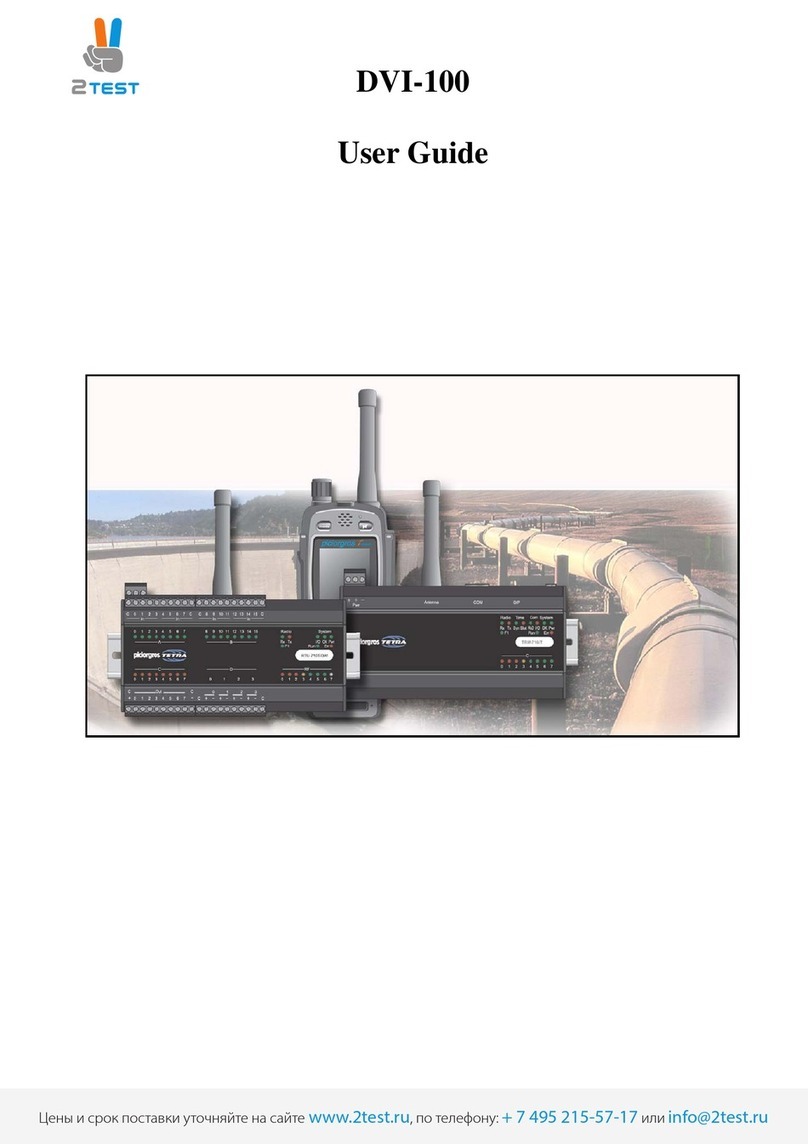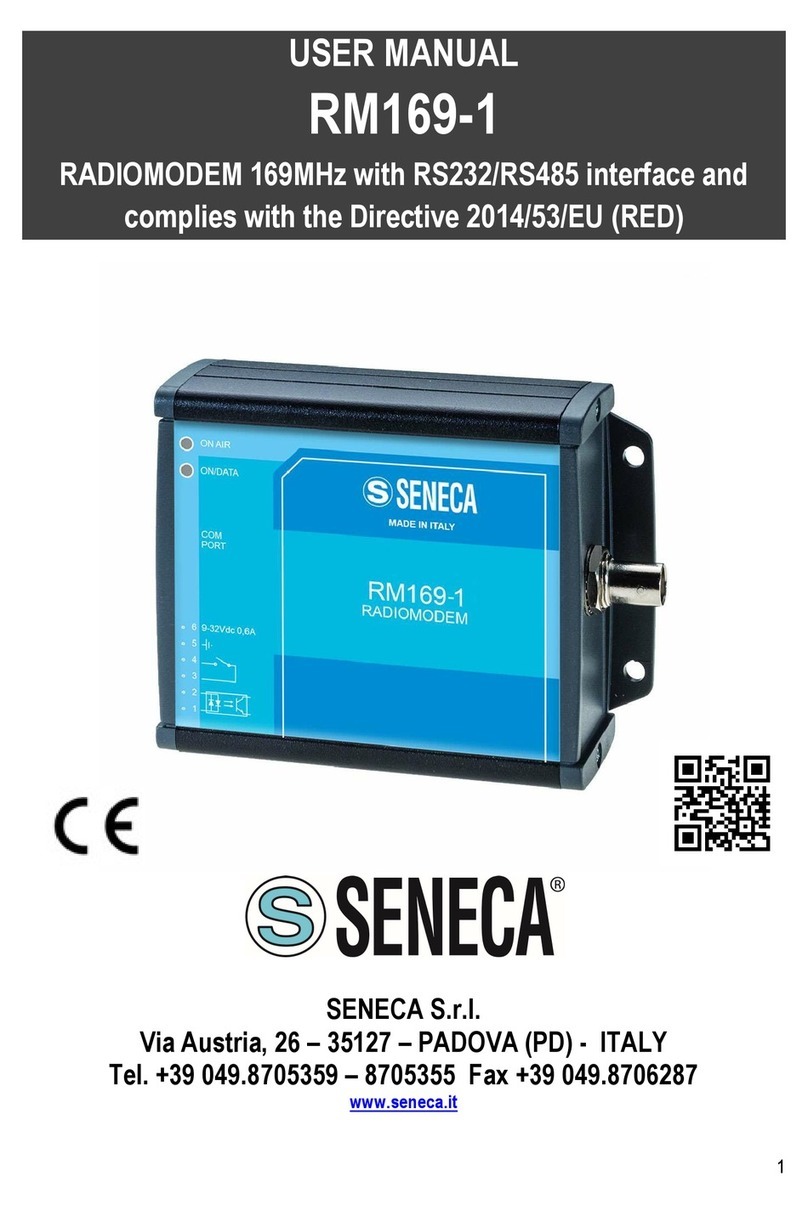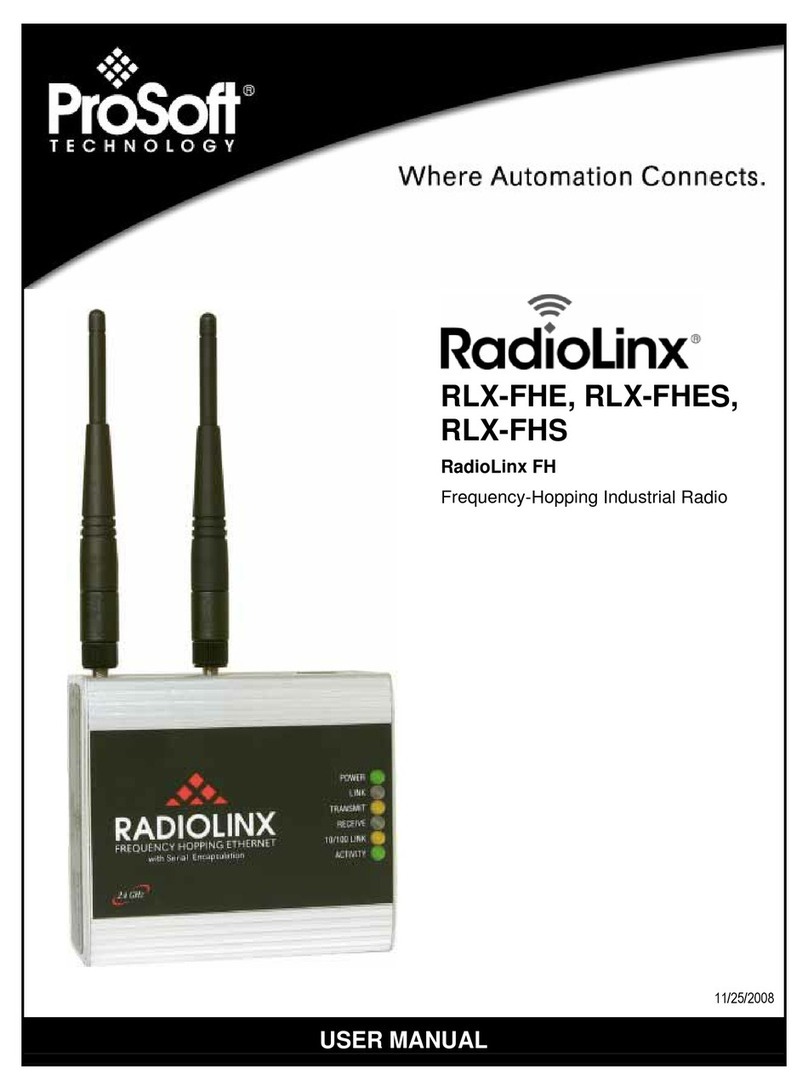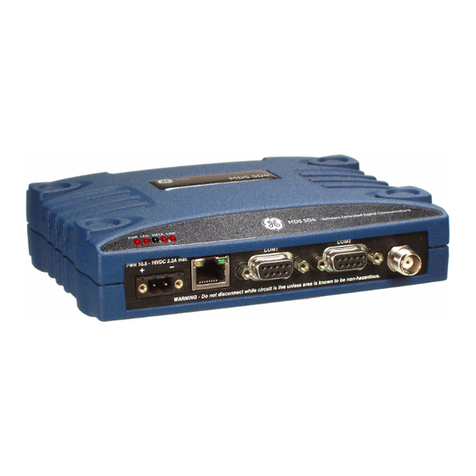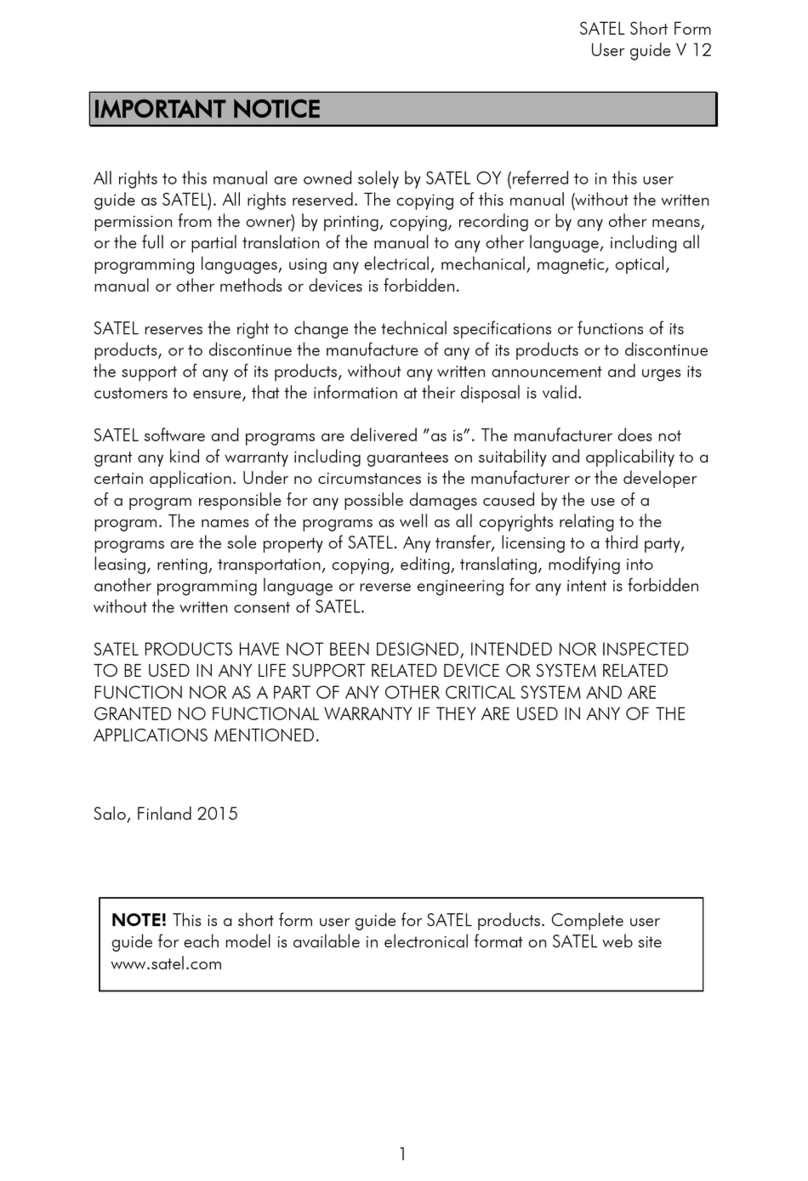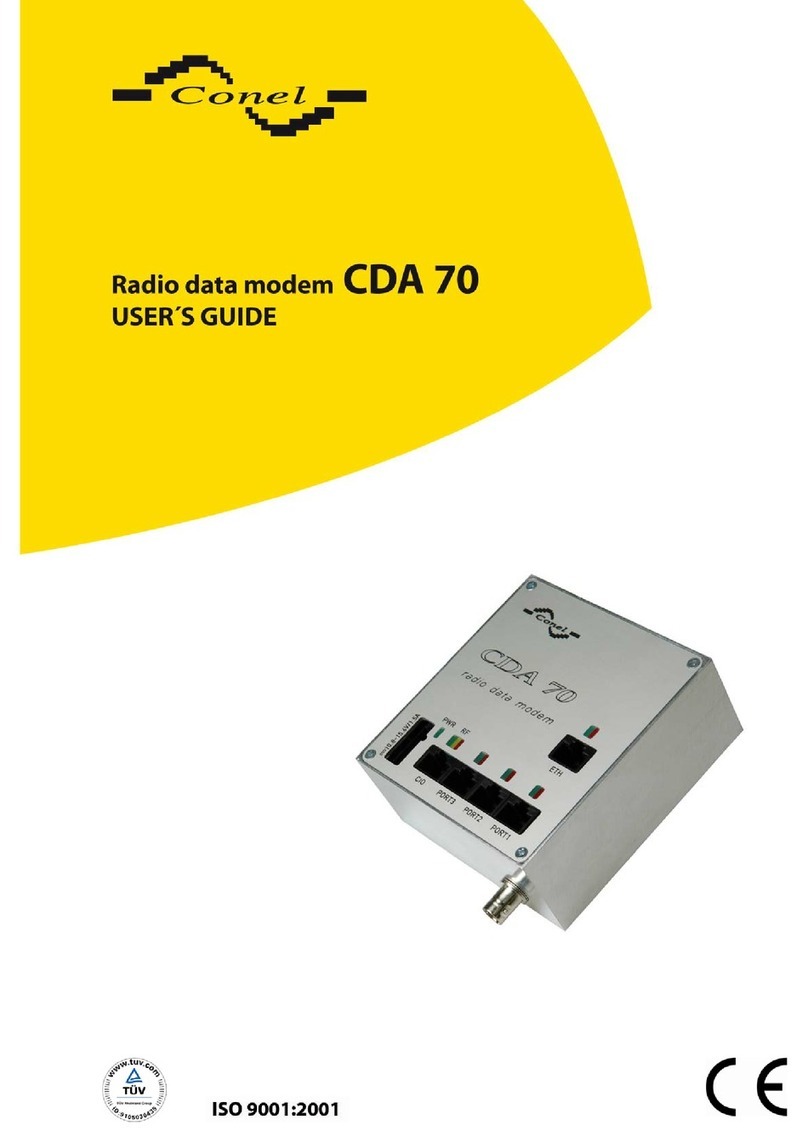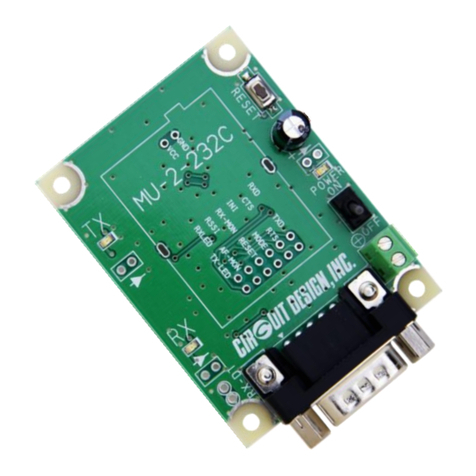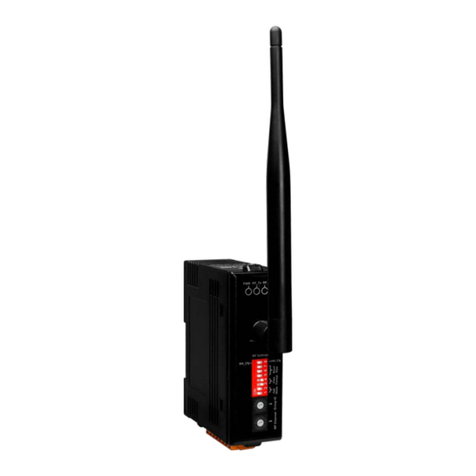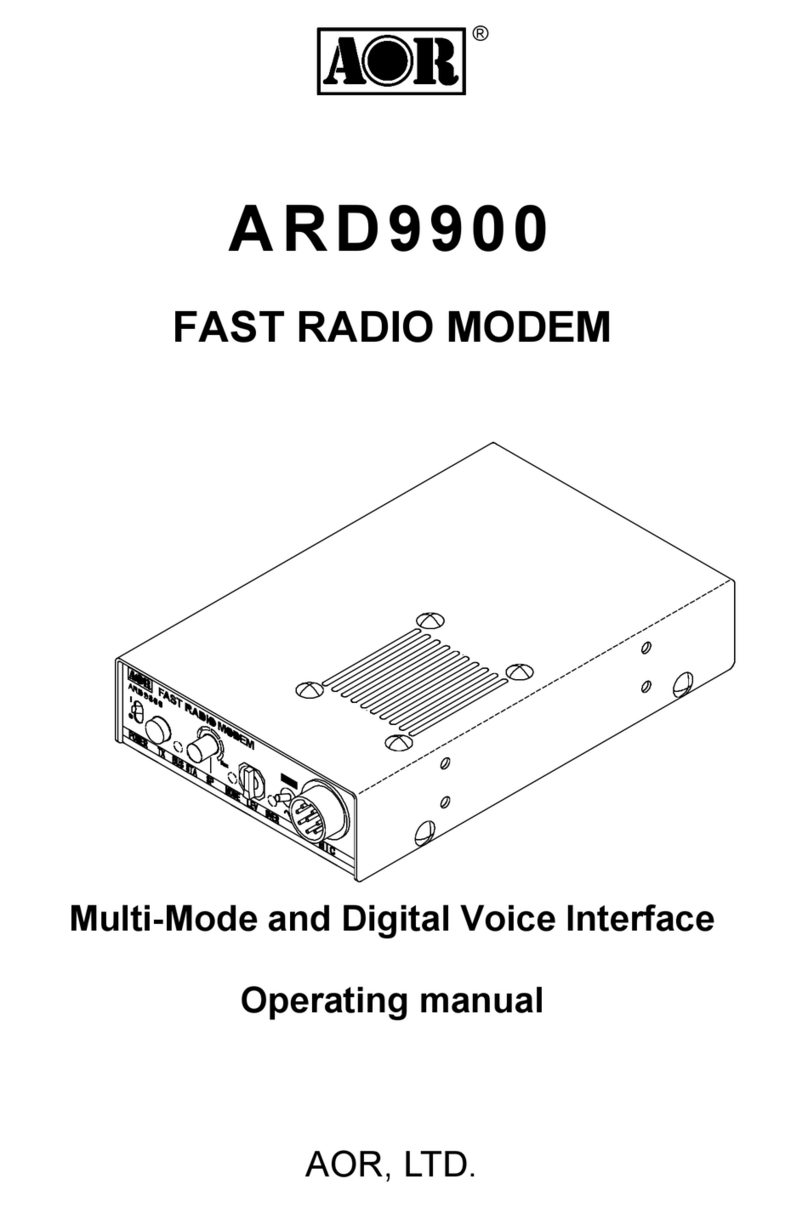Omega OMEGABUS A2400 User manual

omega.com
e-mail: [email protected]
For latest product manuals:
omegamanual.info
User’s Guide
A2400 Series
Radio Modem Module
Shop online at
MADE IN

Servicing North America:
U.S.A.: One Omega Drive, Box 4047
ISO 9001 Certified Stamford, CT 06907-0047
Tel: (203) 359-1660 FAX: (203) 359-7700
e-mail: [email protected]
Canada: 976 Bergar
Laval (Quebec) H7L 5A1, Canada
Tel: (514) 856-6928 FAX: (514) 856-6886
e-mail: [email protected]
For immediate technical or application assistance:
U.S.A. and Canada: Sales Service: 1-800-826-6342 / 1-800-TC-OMEGA®
Customer Service: 1-800-622-2378 / 1-800-622-BEST®
Engineering Service: 1-800-872-9436 / 1-800-USA-WHEN®
Mexico: En Espan˜ol: (001) 203-359-7803 e-mail: [email protected]
Servicing Europe:
Benelux: Postbus 8034, 1180 LA Amstelveen, The Netherlands
Tel: +31 (0)20 3472121 FAX: +31 (0)20 6434643
Toll Free in Benelux: 0800 0993344
e-mail: [email protected]
Czech Republic: Frystatska 184, 733 01 Karvina´, Czech Republic
Tel: +420 (0)59 6311899 FAX: +420 (0)59 6311114
France: 11, rue Jacques Cartier, 78280 Guyancourt, France
Tel: +33 (0)1 61 37 2900 FAX: +33 (0)1 30 57 5427
Toll Free in France: 0800 466 342
e-mail: [email protected]
Germany/Austria: Daimlerstrasse 26, D-75392 Deckenpfronn, Germany
Tel: +49 (0)7056 9398-0 FAX: +49 (0)7056 9398-29
Toll Free in Germany: 0800 639 7678
e-mail: [email protected]
United Kingdom: One Omega Drive, River Bend Technology Centre
ISO 9002 Certified Northbank, Irlam, Manchester
M44 5BD United Kingdom
Tel: +44 (0)161 777 6611 FAX: +44 (0)161 777 6622
Toll Free in United Kingdom: 0800-488-488
e-mail: [email protected]
OMEGAnet®Online Service Internet e-mail
omega.com [email protected]
It is the policy of OMEGA Engineering, Inc. to comply with all worldwide safety and EMC/EMI
regulations that apply. OMEGA is constantly pursuing certification of its products to the European New
Approach Directives. OMEGA will add the CE mark to every appropriate device upon certification.
The information contained in this document is believed to be correct, but OMEGA accepts no liability for any
errors it contains, and reserves the right to alter specifications without notice.
WARNING: These products are not designed for use in, and should not be used for, human applications.

A2400 USERS MANUAL
REVISED: 4/17/95
OMEGA ENGINEERING
ONE OMEGA DRIVE
P. O. BOX 4047
STAMFORD, CT 06907
PHONE: 1-800-DAS-IEEE
FAX: 203-359-7990
e-mail: [email protected]
www.omega.com
The information in this publication has been carefully checked and
isbelievedtobeaccurate;however,noresponsibilityisassumedfor
possibleinaccuraciesoromissions.Applicationsinformationinthis
manualisintendedassuggestionsforpossibleuseoftheproducts
andnot as explicit performancein a specific application.Specifica-
tions may be subject to change without notice.
The A2400 series are not intrinsically safe devices and should not
be used in an explosive environment unless enclosed in approved
explosion-proof housings

TABLE OF CONTENTS
CHAPTER 1 Getting Started
Quick Hook-Up 1-3
Default Mode 1-4
CHAPTER 2 Functional Description
Block Diagram 2-1
CHAPTER 3 Communications
RS-485 3-2
Multi-party Connection 3-3
RS-485 Multidrop System 3-4
CHAPTER 4 Command Set
Table of Commands 4-6
User Commands 4-6
Error Messages 4-13
CHAPTER 5 Setup Information and Command
Command Syntax 5-1
Setup Hints 5-8
CHAPTER 6 Delay Time Programming
CHAPTER 7 Power Supply
CHAPTER 8 Troubleshooting
CHAPTER 9 Extended Addressing
CHAPTER 10 Transparent Mode

Chapter 1
Getting Started
Introduction
This manual describes the function and application of the Radio Modem
Interface Module (A2400). The A2400 provides an intelligent interface
between radio modems available from many manufacturers and devices
designed to operate on a bi-directional RS-485 serial bus. Although the
A2400 has been designed specifically for our family of industrial I/O
modules, it may also be used with other RS-485 devices.
Figure 1.1 depicts a typical application that incorporates A2400’s. In many
data acquisition situations, the sensor data is inaccessible to the host
computer due to large distances or the lack of telephone facilities to
incorporateconventionaldial-upmodems.Insomecases,sensordatamay
have to be monitored full time and the cost of telephone service can be
prohibitive.Fortheseandamultitudeofotherreasonstheuseofaradiolink
can be the best solution.
Unfortunately,radio modemsaredesignedforcomputer-to-computercom-
munications and require a certain amount of intelligence at each radio site
in order to construct useful systems. The cost of a local computer at each
radiocaneasilymakethe concept impractical. The Radio Modem Interface
Module(A2400)fillstheneedforalow-costintelligentinterfacebetweenthe
radio modem and the RS-485 data acquisition devices.
In a typical system as shown in Figure 1.1, there is one host or master
computer and any number of slave sites. The master radio transmitter and
the slave receivers communicate on the same radio frequency, and of
course,theslavetransmittersandthemasterreceiveraretunedtothesame
frequency. While it is common to use two frequencies for simultaneous
transmitting and receiving, it is possible to use one frequency for all
communications. In an idle condition all slave transmitters are turned off.
Each slave site is assigned a unique address so that the master may direct
commands to a particular site. To initiate a communications sequence, the
masterwilltransmita commandbyradiowhichis receivedbyalltheslaves.
Thetransmittedcommandcontainsanaddresswhichdirectsthecommand
to a particular slave site. The slave site that matches the address will
respond to the command. At this time, the addressed slave site will turn on
itsradiotransmitterandcommunicatebackto themasterinresponsetothe
command. Once the response is complete the slave will turn off the
transmitter and wait for a new command. To avoid interference, only one
slave transmitter can be on at any given time. The primary function of the

Getting Started 1-2
A2400 is to control the slave transmitter to allow multiple slave sites.
Figure 1.1 System Overview.
Leased Lines
This manual has been written with emphasis on radio modems. However,
the A2400’s may be used just as effectively with leased telephone lines.
Typically, leased lines do not have dial-up capability and some means of
addressingandmultiplexingmustbeemployedifmultiplestationsareused.
A2400’s may be used with leased line modems in an identical manner as
with radio modems.

Getting Started 1-3
Getting Started
To get your A2400 up and running for an initial check-out, connect the unit
to a power supply and terminal as shown in Figure 1.2. The power supply
can be any dc source from 10 to 30 volts, capable of 1 Watt of power. The
terminal can be any RS-232 dumb terminal set for 300 baud. A computer
configuredasaterminalcanalsobeused.BesuretogroundtheDEFAULT*
pin.
Figure 1.2 A2400 Quick Hookup.
After checking the connections, power up the A2400. Type the following
command on the terminal:
$1RD
Makesuretouseuppercasecharactersforthe‘RD’(ReadData)command
andterminate the command withacarriagereturn. The A2400shouldreply
with the message:
*+99999.99

Getting Started 1-4
Thismessageisterminatedwithacarriagereturn.Iftheresponsemessage
cannot be obtained, re-check all the wiring, making sure that the proper
power is on the A2400 connector and that the DEFAULT* line is shorted to
the GND pin. The terminal must be set to 300 baud.
If, after several attempts, the response message does not appear, refer to
Chapter 8 Troubleshooting in this manual.
If you have an IBM PC or compatible computer, running the S1000 setup
software will ease the task of setting up the A2400 for your application.
AfterestablishingcommunicationswiththeA2400,readthemanualandfeel
free to experiment with the various commands and setups available. If
communicationsislostduetoanimpropersetup,returningbacktothehook-
up of Figure 1.2 will restore communications to the A2400.
Default Mode
The A2400 contains an EEPROM (Electrically Erasable Programmable
ReadOnlyMemory)tostoresetupinformation.TheEEPROMreplacesthe
usualarrayofswitches necessarytospecifybaudrate, address,parity,etc.
The memory is nonvolatile which means that the information is retained
even if power is removed. No batteries are used so it is never necessary to
open the module case.
The EEPROM provides tremendous system flexibility since all of the setup
parameters may be configured remotely through the communications port
withouthavingtophysically changeswitchsettings.Thereis oneoneminor
drawbackinusingEEPROMinsteadofswitches;thereisnovisualindication
of the setup information in the module. It is impossible to tell just by looking
at the A2400 what the baud rate, address, parity and other settings are. It
is difficult to establish communications with a A2400 whose address and
baud rate are unknown. To overcome this, the A2400 has a pin labeled
DEFAULT*. By connecting this pin to ground (GND) the A2400 is forced to
a known communications setup called Default Mode.
TheDefaultMode setup is: 300 baud, no parity, any addressisrecognized.
Grounding the DEFAULT* pin does not change any of the setups stored in
EEPROM.ThesetupmaybereadbackwiththeReadSetup(RS)command
to determine the communications parameters stored in the A2400.
AnA2400 in Default Mode will respond toany address except the six illegal

Getting Started 1-5
values (NULL, CR, $, #, {, }). A dummy address must be included in every
command for proper responses.
Setup information in an A2400 may be changed at will with the SetUp (SU)
command. Baud rates and parity setups may be changed without affecting
the Default values of 300 baud and no parity. When the
DEFAULT* pin is released, the module automatically performs a program
reset and configures itself to the baud rate and parity stored in the setup
information.
TheDefaultModeisintended to be used with a single module connected to
a terminal or computer for the purpose of identifying and modifying setup
values. During normal operation, the DEFAULT* pin should be left open.

Chapter 2
Functional Description
Block Diagram
The A2400 is an RS-232/RS-485 converter specifically designed to inter-
face D series RS-485 modules to radio modems. To this end the A2400
provides three functions:
1) Perform the RS-232 to RS-485 electrical conversion.
2) Control the data direction of the RS-485 bus.
3) Create hand-shaking signals to control the modem.
A simplified block diagram of the A2400 is illustrated in Figure 2.1. This
shows the RS-485 and RS-232 drivers connected to their respective
interface pins. The A2400 contains two UARTs (Universal Asynchronous
Receiver / Transmitters), one dedicated to each port. The RS-485 port is
connectedtoaUARTthatisintegraltothesupervisorymicroprocessor.The
RS-232portconnectstoasecondUARTexternaltothemicroprocessor.All
datacommunicatedtoandfromtheA2400oneitherportmustpassthrough
the microprocessor. The micro controls the data flow depending on the
content of the data and setup information specified by the user.
The A2400 contains an Electrically Erasable Programmable Read-Only
Memory (EEPROM) which is used to store operating parameters specified
bytheuser.TheEEPROMwillretainthesetupdataevenifpowerisremoved
from the A2400. The EEPROM requires no battery and is guaranteed to
retain data for at least ten years. The setup data stored in the EEPROM
includes the baud rate, address, parity, timing data, etc. When power is
appliedtotheA2400,theinternalmicroprocessorreadsthesetupdatafrom
the EEPROM and automatically configures itself. The setup data may be
downloaded with a terminal or computer connected to the RS-232 port.

Functional Description 2-2
EEPROM
MICRO-
PRCESSOR +5
5.6K
DO0/RTS
RX
TX
CTS
RTS
+5V
UART
RX
TX
DEFAULT
Figure 2.1 A2400 Block Diagram.

Functional Description 2-3
Pinout
1) TRANSMIT This is the RS-232 Transmit output from the A2400. This
pin is normally connected to the Receive input of a modem. This output is
also used to connect to a terminal or computer to configure the A2400
2) RECEIVE This is the RS-232 Receive input of the A2400. This pin is
normally connected to the Data Output of a radio modem. This input is also
used to connect to a terminal or computer to configure the A2400
3) RTS RS-232 Request To Send output. This output is used to
control the transmitter of the modem which allows multiple transmitters to
existonthesamesystem.TheRTSoutputistypicallyconnectedtotheRTS
input of the modem. The timing of the RTS signal is user-configurable with
theT1,T2,T3commands.ThepolarityoftheRTSsignalmaybeconfigured
with the Setup (SU) command.
4) CTS This is the RS-232 Clear To Send input. Some modems
provideasignaltoindicatethatthetransmitterisreadyaftertheRTSlinehas
been asserted. This ready signal may be connected to the CTS input to
provideahardwarehandshaketoprovideafastturn-aroundtime.IftheCTS
line is not used, it may be left open and delay time T2 will function as a
software handshake.
5) DO0/ARTS Thisisadigitaloutputthatcanbeconfiguredtoperformtwo
functions. The function configuration is set by a bit in the Setup (SU)
command. Normally this pin is configured as a general-purpose digital
output. It may be turned on and off by commands from the host computer.
The exact circuit schematic of the output is shown in Fig. 2.1. This circuit
providesanoutputthatisTTLandCMOScompatible.Thediodeinthecircuit
allowsthecollectortobepulledupto30voltstointerfacetorelaysandother
higher-voltagedevices.Thisoutputmay also be configured as an Alternate
RequestToSendsignal.Withthissetup,theARTSsignalexactlymimicsthe
RTSoutput.ThisoutputmaybeusedwhenaTTLsignalisdesiredorahigh-
current open-collector signal is necessary.
6) DEFAULT* By grounding this pin, the A2400 is placed in a known
communication setup. This is essential if the baud rate and address of the
A2400 are not known. The default communications setup is: 300 baud, no
parity, any address is recognized. The DEFAULT* pin should be grounded
only if the A2400 is being setup or configured. In normal operation this pin
is left open.
7) (Y)DATA+ Thisisthepositivepolaritysignalof thedifferentialRS-485

Functional Description 2-4
bus. This bus connects to multidrop RS-485 devices such as D series
modules.
8) (G)DATA- This is the negative polarity of the differential RS-485 bus.
9) (R)V+ A2400power connection.TheA2400 operateson10 to30
volts dc.
10) (B)GND This is the ground connection common to all circuits. The
A2400doesnothaveisolationbetweenpowerandthetwocommunications
ports.
Notethatpins7through10aredesignatedY,G,R,andBrespectively.This
corresponds to the Yellow, Green, Red, and Black colors normally found in
commontelephonecable.AllDseriesRS-485devicescarrythisnomencla-
ture. If all yellow connections are connected together, and green to green,
etc., the RS-485 wiring will be correct.
RS-485 Termination
The RS-485 port lines are terminated as shown in Fig. 2.1. The 220 ohm
resistor is used as a transmission line terminator to improve signal fidelity.
A similar 220 ohm resistor should be installed at the far end of the RS-485
bus. The 1 K ohm resistors are used to bias the signal lines to a Mark
condition.ThisisnecessarywhenalltransmittersoftheRS-485busareoff,
which is the most prevalent condition. The resistor bias helps to prevent
noise pickup.
The RS-485 port is protected from potentially destructive voltages with
positive temperature coefficient thermistors and transient suppressors.
A2400 Operation
A typical installation is shown in Figure 3.1(see Chapter 3). The A2400 is
used to provide an interface between a modem and a string of standard
modules. Each module and the A2400 has a unique address. In a typical
communications sequence the host computer and radio (not shown) will
transmitamodulecommandovertheair.The modemreceiverpicksupthe
message data and presents it to the A2400 on the RS-232 port.
Character Filter
Due to the nature of radio data transmission, noisy data is almost always
present at the output of the modem. This is due to inadequate squelch or
noise generated when radio transmitters are turned on and off. The A2400
uses noise reduction techniques to reduce the possibility of bad characters

Functional Description 2-5
reaching the RS-485 bus.
The first operation performed on the modem data is to check for noise and
framingerrors.Ifeitherconditionexists,thebadcharacterisre-formattedas
a null character (ASCII $00). Since the null is not a legal character for use
asanaddressinthemodules,transmittinganullispreferabletoabortingthe
character when an error is detected. This cuts down on the possibility of a
module being incorrectly addressed.
After noise and framing errors are checked, the data must be qualified with
a character filter. This filter will flush any data until a valid prompt character
is detected. These characters are: ‘$’, ‘#’, ‘{‘, and ‘}’. Parity is ignored. Once
a prompt character is received, The A2400 assumes that a valid command
is being transmitted. The A2400 will transfer the data to the RS-485 bus or
hold it in an internal buffer depending on the address data. At this time the
character filter checks for a carriage return character which terminates the
command.Ifacarriagereturnisdetected,thecharacterfilterisresettoflush
charactersuntilanothervalidpromptis found. If 32 characters are received
after a prompt without a carriage return found, the data is considered to be
noisy and the character filter is reset for prompt detection.
The character filter may be disabled for non-D series systems.
The qualified data may take one of two paths depending on the address
data. Commands addressed to the A2400 itself are not transmitted on the
RS-485bus.Thereforethepromptcharacterissavedinbuffermemoryuntil
the address character can be examined. If the A2400 detects its own
address, the subsequent command data is processed internally to the
A2400. No data will appear on the RS-485 bus.
If the address does not match the A2400, the prompt and address charac-
tersaretransmittedtotheRS-485port,alongwithanysubsequentdatauntil
a carriage return or character over-run occurs.
The A2400 ignores parity on all data except for commands addressed to
itself.
The RS-485 port is normally in receive mode, and when the A2400 places
data on the bus it enables the RS-485 transmitter on a per-character basis.
This means that the port is returned to receive mode immediately after a
command has been transmitted.
Assume that a module on the RS-485 bus has received a correctly

Functional Description 2-6
addressedcommandanditrespondsbackwithinformationonthebus.The
A2400 receives this information and places it in a buffer that can hold up to
96 characters. The parity of received characters is ignored. As soon as a
character is received, the A2400 starts a timing sequence to control the
modem transmitter. Three user-programmable timers, T1, T2, and T3
control the data flow. See Figure 2.2
.
Figure 2.2 Programmable Delay Times.

Functional Description 2-7
T1
AssoonastheA2400detectsacharacterintheRS-485receivebuffer,time
delayT1is activated. This is a dead time to allowthehost to prepare for the
receiptofamessage. Thisisparticularlyimportantwhen asimplexconnec-
tion is used, where the send and receive data is transmitted on the same
frequency. During this time the A2400 creates no control output, but any
data received on the RS-485 port is stored in the receive buffer. At the end
of time T1, the A2400 asserts the RTS control signal to ‘key’ or turn on the
transmitter of the radio.
T2
Once the RTS signal has been asserted, the T2 delay is activated. This is
adelay time to allow thetransmitter to power up andsettle in anticipation of
atransmissionbacktothehost.Thesettlingtimerequiredisspecifiedbythe
modemmanufacturer.When the T2 time period is over, the A2400willstart
to transmit the data held in the receive buffer, and will continue to transmit
until the buffer is empty.
Some radio modems provide a CTS (Clear To Send) signal that indicates
that the transmitter has settled and is ready for data. This signal may be
connectedtotheCTSinputoftheA2400toprovidehardwarehandshaking.
The delay period T2 ends when either the CTS signal is detected or the T2
timer ends, whichever comes first.
T3
TheA2400willtransmitdatatothe modemuntilthereceivebufferisempty.
Whenthe receivebufferis empty,andthe lastcharacterhasbeen transmit-
ted,timedelayT3isactivated.T3providestwofunctions:itprovidesaclean
breakbetweenthetransmitteddataand theturn-offoftheradiotransmitter,
anditallowsthehosttopollmoredatawithoutkeyingthetransmitteronand
off. During time T3, the host may transmit another command which would
pass through the A2400 to the RS-485 bus. Typically, this command would
generatearesponsefromadevice ontheRS-485bus.Iftheresponsedata
is received by the A2400 before T3 is complete, T3 is canceled and the
received data is immediately transferred to the modem. When the receive
bufferisempty,T3isactivatedagain,andthecyclerepeatsitself.Thisallows
the host to establish communications with the remote radio and talk back
and forth without wasting time re-keying the transmitter for each response.
If T3 times out and the receive buffer is empty, the radio connection is
terminated by turning off the RTS signal.

Chapter 3
Communications
Introduction
TheA2400 moduleshavebeen carefullydesignedto beeasytointerface to
allradiomodemsandmanyleased-linemodems.Allcommunicationstoand
fromthemodulesareperformedwithprintableASCIIcharacters.Thisallows
the information to be processed with string functions common to most high-
levellanguagessuchasBASIC.TheASCIIformatmakessystemdebugging
easy with a dumb terminal.
This system allows multiple modules to be connected through the A2400 to
amodemwithasingle4-wirecable.Upto32RS-485modulesmaybestrung
together on one cable; 121 with repeaters. The modules communicate with
thehostonapollingsystem;thatis,eachmodulerespondstoitsownunique
address and must be interrogated by the host. A module can never initiate
a communications sequence. A simple command/response protocol must
be strictly observed to avoid communications collisions and data errors.
Communication to the A2400 modules is performed with two- or three-
character ASCII command codes such as RD for Read Data. A complete
description of all commands is given in the Chapter 4. A typical command/
response sequence would look like this:
Command: $1RD
Response: *+99999.99
A command/response sequence is not complete until a valid response is
received. The host may not initiate a new command until the response from
a previous command is complete. Failure to observe this rule will result in
communications collisions. A valid response can be in one of three forms:
1) a normal response indicated by a ‘ * ‘ prompt
2) an error message indicated by a ‘ ? ‘ prompt
3) a communications time-out error
When a module receives a valid command, it must interpret the command,
perform the desired function, and then communicate the response back to
thehost.Each command has an associated delay time in whichthemodule
is busy calculating the response. If the host does not receive a response in
an appropriate amount of time specified in Table 3.1, a communications
time-outerrorhasoccurred.Afterthecommunicationstime-outitisassumed
that no response data is forthcoming. This error usually results when an

Communication 3-2
improper command prompt or address is transmitted. The table below lists
the timeout specification for each command assuming that delay times T1,
T2, T3 = 0:
Table 3.1 Response Timeout Specifications.
Mnemonic Timeout
DO, OC, CC, RD, REA, RID, RLP, RS, RSP, RSU, ≤10 ms
RT1, RT2, RT3, WE
EA, ID, LP, RID, RR, SP, SU, T1, T2, T3 ≤100 ms
The timeout specification is the turn-around time from the receipt of a
command to when the module starts to transmit a response.
Data Format
AllA2400 modulescommunicate instandard NRZasynchronous data
format. This format provides one start bit, seven data bits, one parity
bit and one stop bit for each character.
RS-485
RS-485 is a recently developed communications standard to satisfy the
need for multidropped systems that can communicate at high data rates
over long distances. RS-485 is similar to RS-422 in that it uses a balanced
differentialpairofwiresswitchingfrom0to5Vtocommunicatedata.RS-485
receiverscanhandlecommonmodevoltagesfrom-7Vto+12Vwithoutloss
of data, making them ideal for transmission over great distances. RS-485
differsfromRS-422byusingonebalancedpairofwiresforbothtransmitting
and receiving. Since an RS-485 system cannot transmit and receive at the
same time it is inherently a half-duplex system. RS-485 offers many
advantages over RS-232:
1) balanced line gives excellent noise immunity
2) can communicate with modules at 38400 baud
3) communications distances up to 10,000 feet.
4) true multidrop; modules are connected in parallel
5) individual modules may be disconnected without affecting
other modules
6) up to 32 modules on one line; 124 with repeaters
7) no communications delay due to multiple modules
8) simplified wiring using standard telephone cable
An RS-485 system usually requires an interface such as the A2400 to
convert RS-232 to RS-485.

Communication 3-3

Communication 3-4
RS-485 Multidrop System
Figure 3.1 illustrates the wiring required for multiple-module RS-485
system.NoticethateverymodulehasadirectconnectiontotheA2400.Any
number of modules may be unplugged without affecting the remaining
modules. Each module must be setup with a unique address and the
addresses can be in any order. All RS-485 modules must be setup for no
echo to avoid bus conflicts (see Setup). Also note that the connector pins
on each module are labelled with notations (B), (R), (G), and (Y). This
designates the colors used on standard 4-wire telephone cable:
Label Color
(B) GND Black
(R) V+ Red
(G) DATA- Green
(Y) DATA+ Yellow
This color convention is used to simplify installation. If standard 4-wire
telephonecableis used, it is only necessary to match thelabeledpins with
the wire color to guarantee correct installation.
To minimize unwanted reflections on the transmission line, the bus should
be arranged as a line going from one module to the next, starting with the
A2400. ‘Tree’ or random structures of the transmission line should be
avoided.Forwirerunsgreaterthan500feettotal,theendofthebusshould
beterminatedwitha220ΩresistorconnectedbetweenDATA+andDATA-
. The A2400 has a resistor built in to terminate the start of the bus.
Whenusingabi-directionalRS-485system,thereareunavoidableperiods
of time when all stations on the line are in receive mode. During this time,
thecommunicationslinesareleftfloatingandareverysusceptibletonoise.
To prevent the generation of random characters, the lines are biased in a
MARKcondition asshowninFigure 2.1.The1Kresistors areusedto keep
theDATA+linemorepositivethantheDATA-linewhennoneoftheRS-485
transmittersareon.Whenenabled,thelowimpedanceofanRS-485driver
easily overcomes the load presented by the resistors.
Special care must be taken with very long busses (greater than 1000 feet)
to ensure error-free operation. Long busses must be terminated as de-
scribedabove.TheuseoftwistedcablefortheDATA+andDATA-lineswill
greatlyenhancesignalfidelity.Useparityandchecksumsalongwiththe‘#’
form of all commands to detect transmission errors. In situations where
many modules are used on a long line, voltage drops in the power leads
Table of contents
